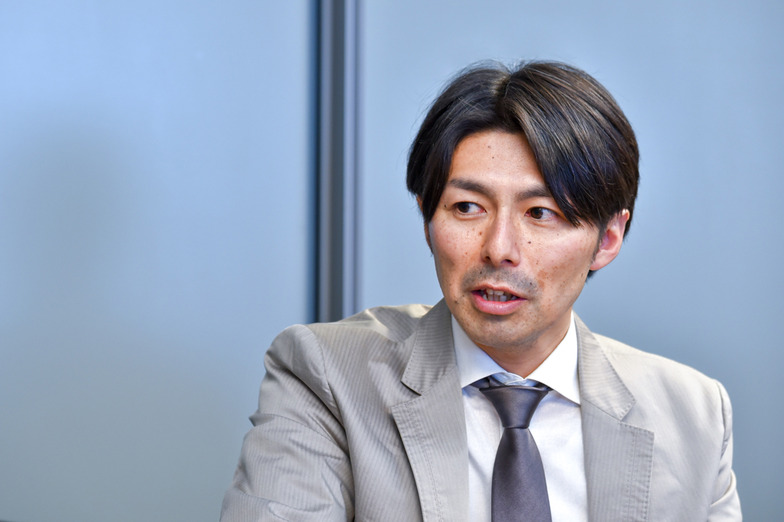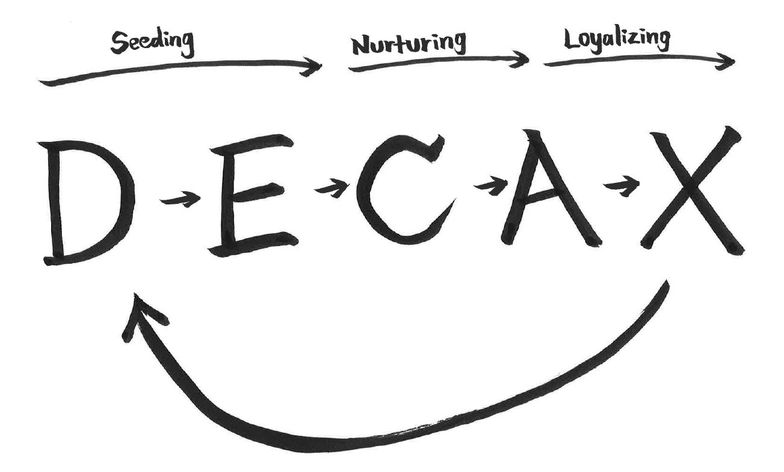Traditionally, advertising has used models like AIDMA and AISAS to explain purchasing behavior. However, in an era where information spreads through social media and consumers move from content to content, a different approach is needed. Surprisingly, a hint for this came from Singapore. This time, we present a three-way discussion (Part 1) featuring Mr. Naito from Dentsu Digital Inc. Holdings (DDH) Singapore, who developed a new hypothesis while working on-site, and Mr. Aoki from BCC, who introduced him to Tokyo.

(From left) Mr. Aoki, Mr. Gunji, Mr. Naito
The DECAX Idea
Gunji: First, could you tell us how you got involved in content marketing, Mr. Naito?
Naito: At DDH Singapore, I'm primarily responsible for supply-side business development in Southeast Asia. Specifically, this involves developing display inventory using SSPs and AdExchanges.
One day, I saw an article featuring my colleague Aoki in Director Gunji's Dentsu Inc. newsletter. I thought, "What's he up to?" and read it. Learning he was doing content marketing, I realized it was the perfect way to monetize the high-quality content and creative capabilities that publishers possess. That was the starting point.
Gunji: So the trigger was surprisingly close at hand (laughs).
Naito: Previously, I had considered a company providing a content discovery platform as a potential investment target for the DDH Fund. Combining that information with Director Gunji's Dentsu Inc. Report and conversations with advanced global clients in Southeast Asia finally made me realize the new potential of content marketing. Actually, I was about two cycles behind (laughs).
Gunji: But since Singapore is the Asian hub for these cutting-edge clients, wouldn't the challenges in content marketing also be more advanced, allowing for various proposals?
Naito: Well, it's not quite that simple... (laughs). When we actually tried incorporating Outbrain into our proposals, it ended up looking like just another CPC-based product. We had to start by proposing branded content production instead.
When we break it down into concrete tasks, we go through trial and error where the potential for content marketing I initially sensed seems to get lost. I felt we needed to create a model like AISAS for content marketing, which isn't yet clearly defined.
Gunji: That's how you arrived at the DECAX idea, right?

Naito: Exactly. Of course, media landscapes vary drastically by country, and I fully understand the absurdity of building a one-size-fits-all model in the digital world. But we developed it considering the changes in consumers' information behavior driven by technological evolution, and the need for clear explanation to clients. It's called "DECAX," derived from Discovery → Engage (rational attitude) → Check (confirmation or attention) → Action → eXperience (the experience itself) and its sharing.
This is a hypothesis regarding the already-emerging changes in consumers' information behavior and the future trajectory extending from it; it is not empirical.
Aoki: It's true it's only a hypothesis, but as a proposed framework, it's quite explanatory. It effectively organizes what elements are needed in each process and what kind of partners are required. Now, let's dive right into explaining each step in detail.
Discover
Naito: This is a personal experience as a consumer, but recently my perception of a certain car company changed significantly. While TV commercials I encountered during occasional trips back to Japan were a major factor, what truly transformed my perception was precisely the recommended branded content. I actively clicked on it when my curiosity and receptivity to information were at their peak, so just one exposure completely hooked me.
Reflecting on why I was so deeply influenced, I realized it was precisely because I had discovered and actively sought out the information myself.
Mr. Gunji, Mr. Aoki, when you look back, isn't it often the case that the information that sticks in your mind is surprisingly stuff you actively discovered yourself?
Aoki: Yeah, the information that comes to mind now definitely has a strong impression of being something I discovered because I was interested in it.
Gunji: That's true.
Naito: That's why we named it Discover. Specifically, it refers to consumers discovering content based on their own curiosity and interests. From a marketer's perspective, it means creating technology and systems that make consumers feel they discovered it themselves.
My experience above is just one small example, but I believe that in the near future, as data quality and scale improve and technology advances, we'll be able to reproduce this kind of event—which we might dismiss as a minor serendipity—with a high degree of probability. Furthermore, I see this as closer to the essence of advertising that Dentsu Inc. should pursue: uncovering latent needs, beyond the efficient harvesting of explicit needs that internet-specialized agencies focus on. I also hear subscription-based TV services are increasing in Japan recently. It feels like the day when content marketing disguised as "Addressable TV" enters our living rooms isn't far off.
Regarding technologies in this Discover domain, interest graphs and emotional targeting on video already exist. However, from the perspective of uncovering latent needs, I personally anticipate the emergence of exploratory approaches that incorporate probabilistic fluctuations, such as Genetic Algorithms (GA), alongside emphasis filtering and reinforcement learning-based algorithms.

Relationship Building: Engage
Naito: Because users actively Discover content, their Engagement with it happens almost simultaneously. While Discover refers to the technology enabling encounters with content, Engagement signifies the content's inherent power to captivate. It's about how compelling the content is—how well it captures people's attention, even if they stumbled upon it (or were led to it). In the format-free digital environment, the key battle is crafting content that delivers both surprise and conviction.
While there may be various pros and cons and debates surrounding native articles, I believe the key point boils down to how well they could attract the audience and influence their perception. Personally, I don't think debates about format or whether the subject of the content should be the company name or the media outlet name are major issues.
This engagement domain is fundamentally Dentsu Inc.'s area of expertise. Therefore, regarding Hero content within YouTube's proposed HHH (Hero/Hub/Help) strategy, I believe we should leverage creative ideation capabilities rather than purely advertising production skills. On the other hand, when the clear objective is to generate buzz on social media, another approach is to have the community itself generate content they find interesting. This makes community-sourced creative platforms worth considering.
(Rational attitude) Verification and caution: Check
Naito: I believe the era of content marketing has both positive and negative aspects. The positive side is the emergence of a new, more persuasive communication channel. The negative aspect is the decline in society's trust in content.
Influenced by stealth marketing and similar tactics, today's consumers instinctively and instantly discern the authenticity, origin, and underlying intent of information, unconsciously filtering it. I call this process "Check." It's a situation where immunity is rising against content spreading like a virus, making vaccines less effective.
Unfortunately, I haven't found a clear solution to this problem either. However, I believe the only way forward is to stop chasing easy traffic through messaging and instead consistently strive to create high-quality content by carefully considering what information holds real value for both clients and consumers. In other words, it means creating high-quality content that consumers will still find valuable even when approaching product information with a rational attitude.
Action
Naito: Action, of course, refers to purchasing behavior, so I don't think it needs explanation. However, regardless of whether it's offline or online, what's crucial is whether we've thoroughly solidified the needs and maximized engagement during the preceding DEC process. I believe the role of communication in marketing is to "create the necessity to be chosen." Therefore, it would be ideal if we could create situations where we are specifically chosen, bypassing the funneling process.
Experience and its sharing: eXperience
Naito: Recently, I feel it's becoming more common for people to discover new ways to use or appreciate a product after purchase by engaging with online content like how-to guides or tips. Furthermore, as IoT becomes more widespread and products/services become more object-oriented, user-generated hack content will likely increase, accelerating this trend. I've named this process the content eXperience.
From a marketer's perspective, whereas CRM has traditionally pursued the efficiency of promotions such as cross-selling and up-selling, the introduction of the concept of content marketing means that building and deepening relationships with users will also fall within the scope of their responsibilities. Certainly, depending on the industry, some companies have published member magazines and mooks to bond with existing customers, but now all marketers have this opportunity. The content required here corresponds to the Hub/Help content in the previously mentioned HHH strategy, but its production requires a completely different set of skills than the ones traditional agencies have honed in terms of volume, speed, and cost.
In response to this growing demand for content, new players are emerging in this area. For example, a company in Singapore produces and distributes short cooking programs every day for a supermarket chain, using the supermarket's original brand of seasonings and ingredients. We believe it is necessary to continue watching this space.
Continuing with the supermarket example, they aren't just creating this cooking content for existing customers. By distributing the content, they are also driving new Discover—essentially uncovering latent needs. This corresponds to the feedback loop shown in the diagram.
Why DECAX became necessary
Aoki: Naito gave us a brief explanation, but could you please elaborate again on the background that made "DECAX" necessary?
Naito: In short, while content marketing has gained significant traction in Europe and the US, it wasn't being understood in Southeast Asia.
Gunji: So it wasn't just about solving direct marketing communication challenges like ours, but it also became necessary within supply-side business development and partnership building efforts.

Naito: Exactly. Observing Southeast Asian lifestyles, we saw they operate differently from AIDMA or AISAS models, yet no framework existed to explain this. We needed a way to articulate how content marketing represents a new paradigm—or, to put it bluntly, we needed to establish a sense of discontinuity with the past.
Gunji: How did you discover this?
Naito: I had several opportunities to explain content marketing to clients and DAN's local teams. We'd start with small talk as a warm-up. I'd ask, "What kind of content have you seen recently? (Do you remember?)" and then dig deeper: "Where did you see it? How did you find it?" Most people answered, "I was killing time on my phone and saw something that caught my interest, so I clicked." Then I'd ask, "Whether it was Facebook or a recommendation on a portal site, what if it was intentionally placed there, knowing your exact interest or curiosity at that very moment? What would you think?"
Of course, this is a loaded question because it lumps pure content and branded content together indiscriminately. But it was the quickest way to grasp the meaning and potential of content marketing. We developed "DECAX" based on this kind of accumulated experience.
Gunji: I see.
Naito: Through this work, I came to realize that content marketing is indispensable for major clients' digital strategies. While digital is essential for direct-response clients, for non-direct major clients, the only compelling reason to do digital beyond reach cost is hard to find.
That said, major advertisers already have sufficient brand awareness, making reach a difficult campaign objective. Consequently, the structure became building campaign sites and either buying traffic or managing it. Content marketing, however, seems to bring advertising meaning and significance to this somewhat bland process.
Aoki: So, it's about delivering experiences where encountering the content itself can change perceptions, right?
【Gunji's eye】
As mentioned in the main text, DECAX is ultimately just a perspective born from practical fieldwork. I believe it will continue to evolve as new media emerge or new functionalities are added to content.
However, content marketing is not just "a new way to create campaigns," but "a new way to create marketing communication." To reframe it from that perspective, we need to think in terms of new models that didn't exist before. So, can the model discovered in Singapore be applied effectively in Japan? In the second part, we plan to discuss this very point. Stay tuned.











